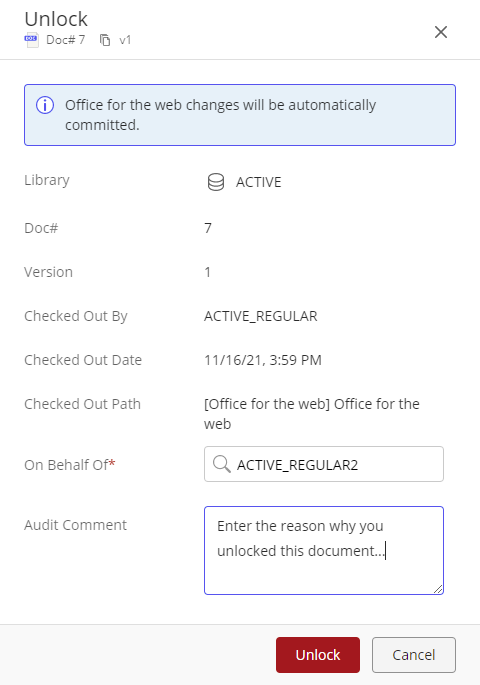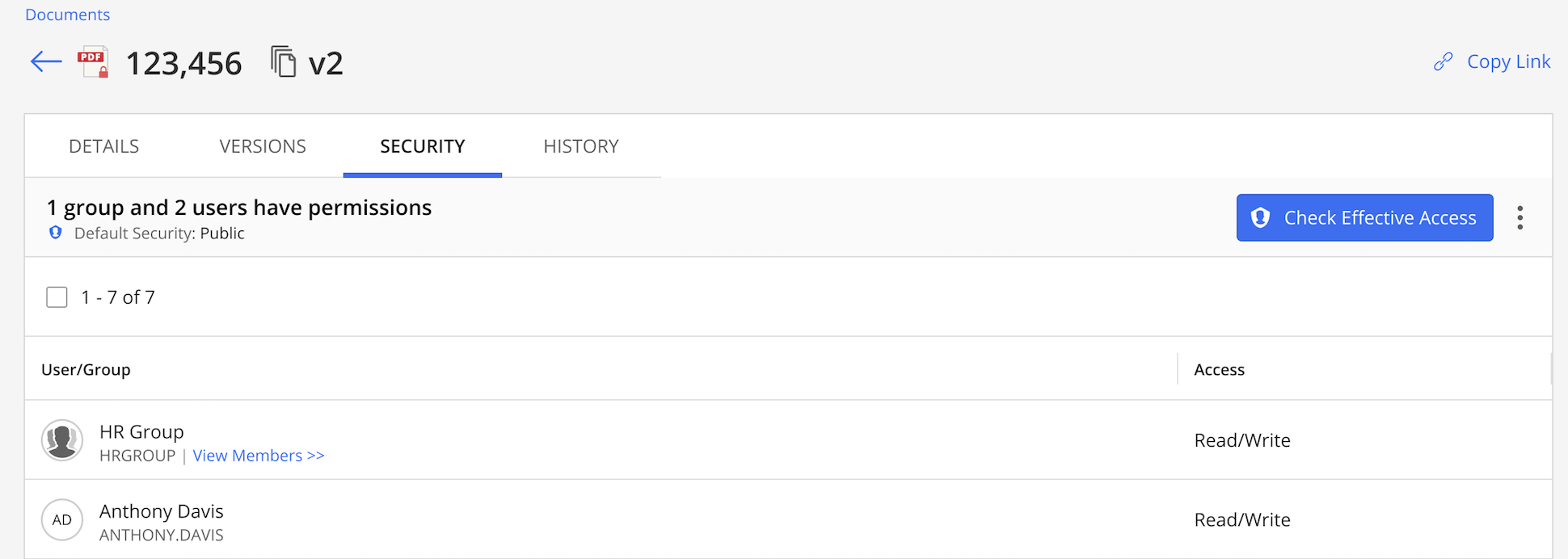Documents
NOTE:
To perform operations on the Documents page, the user signed in to iManage Control Center must be a member of the NRTADMIN group, or be assigned to a role with Tier 1 or Tier 2 access to Control Center. For more information about the specific operations allowed, see Understanding tiers.
The Documents page enables you to search for documents using various search criteria, and perform the following actions on these documents:
- Unlock checked out documents.
- Verify user access rights for the selected document using the Check effective access option.
- Verify user access rights based on the groups assigned in the Access Control List (ACL) using the Security option.
- View the versions of a document.
- View the history of a document.
- View details of a document.
- Copy a link to one or more documents using the Copy Link option.
Searching for documents
Select Content > Documents . The list of default search fields appears as shown in the following figure:
Figure: Documents page

Use these search fields to refine your search, then select Search.
To add more search criteria, select Add Search Criteria.
When you enter search criteria, the Clear values option is also displayed; select it to clear all search criteria you have entered.
In the preceding figure, the Hide Search Criteria option is displayed.
- To hide the search criteria and focus only on the list of documents, select Hide Search Criteria.
- Selecting Hide Search Criteria changes this option to Show Search Criteria . Select this to view the search criteria list.
NOTE:
For performance reasons, search results are limited to 5000 items. If your search exceeds 5000 results, refine the search with additional criteria.
You can alternatively perform searches without the 5000 result limitation using the iManage Work Universal (REST v2) API.
iManage Control Center preserves the search fields you enter when searching for documents, workspaces, or trash. When you add or remove search fields, your settings are automatically saved and will be present the next time you sign in and access the Documents, Workspaces, or Trash pages. This provides the advantage of not having to remember or reselect your search fields for subsequent searches.
Search fields are stored locally in the browser's cache for each individual library. If you switch to a different browser or to a different device, you will see the default search fields.
Unlocking documents
Checked out documents are documents that have been opened for editing by a user. When a document is checked out, no other users can edit the document. The document remains locked until the user who checked out the document saves their changes to iManage Work and closes the document in the application.
In the event that a user forgets or fails to close the file, administrators can unlock the document using iManage Control Center. This enables other users to open and edit the document again.
Any changes made by the user who originally checked out the file must be saved locally. They may also save their changes as a new version of the document in iManage Work.
To unlock a checked-out document:
- In iManage Control Center, browse to Content > Documents.
- In the list of search criteria, locate the CheckedOut option, and select Yes. By default, this value is set to Any.
- (Optional) In Checked Out By, enter the name of the user who checked out the document .
- (Optional) Enter any other search criteria to locate the document, such as Doc. Number.
- Select Search.
In the list of search results, locate the checked-out document that you want to unlock.
- Right-click the document and select Unlock. The Unlock dialog box appears with details about the checked out document.
Figure: Unlock dialog box

- In On Behalf Of, enter the user who requested or authorized the document to be unlocked.
- In Audit Comment, enter any information useful for auditing this unlock operation.
- Select Unlock to unlock the document.
Checking effective access
To verify the access rights of a user for a selected document, use the Check Effective Access option. It evaluates all permissions (default security, access permission, group memberships, and role abilities).
It is available on the:
- Ribbon bar: Select a document to see this option on the ribbon bar.
- Kebab menu: Select
 next to each document to see this option.
next to each document to see this option. - Context menu: Right-click a document to see this option.
Use one of the preceding options to check the effective access of the document.
- Right-click a document and select Check Effective Access . The following dialog box appears:
Figure: Check Effective Access
- Enter a user name or ID. A suggestion list appears.
- Select a user. The effective access of the selected user for the document is displayed.
Verifying security
To verify access permissions for the users and groups assigned in the Access Control List (ACL), use the Security option. It is available on the:
- Ribbon bar: Select a document to see this option on the ribbon bar.
- Kebab menu: Select
 next to each document to see this option.
next to each document to see this option. - Context menu: Right-click a document to see this option.
- Right-click on a document and select Security.
Security details for the document are displayed. The following figure shows an example:
Figure: Security
Viewing document versions
Use this feature to view the versions of a document. It is available on the:
- Ribbon bar: Select a document to see this option on the ribbon bar.
- Kebab menu: Select
 next to each document to see this option.
next to each document to see this option. - Context menu: Right-click a document to see this option.
Use one of the preceding options to view the document versions. On the Versions tab, the following fields are displayed in addition to the version details:
- Author
- Custom field 1
- Custom field 2
- Checked Out By
- Checked Out Date
- Last Edited By
- Last Edited Date
Viewing document history
Use this option to see the history of a document. It is available on the:
- Ribbon bar: Select a document to see this option on the ribbon bar.
- Kebab menu: Select
 next to each document to see this option.
next to each document to see this option. - Context menu: Right-click a document to see this option.
Use one of the preceding options to view the document history. On the History tab, the following details are displayed:
- Date
- User
- Activity
- Application
- Duration
- Pages Printed
- Location
- Comments
Viewing document details
This option is available on the:
- Ribbon bar: Select a document to see this option on the ribbon bar.
- Kebab menu: Select
 next to each document to see this option.
next to each document to see this option. - Context menu: Right-click a document to see this option.
- Clickable link: In the Doc #/Version column, select a document.
Use one of the preceding options to view the document details. You see the following details:
- Library
- Doc#
- Version
- Name
- Author
- Class_EN
- Type
- Operators
- Locations
Copying document link
Use this option when you want to share the document link with a customer, partner, or others through email. It is available on the:
- Ribbon bar: Select a document to see this option on the ribbon bar.
- Kebab menu: Select
 next to each document to see this option.
next to each document to see this option. - Context menu: Right-click a document to see this option.
Use one of the preceding options to copy the link for the document to the clipboard.